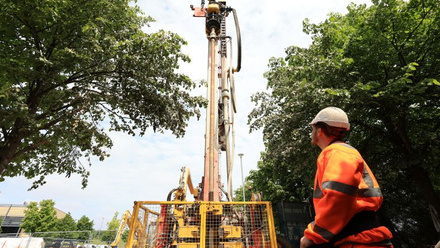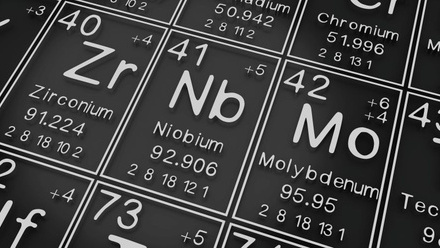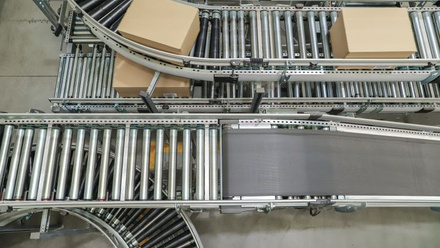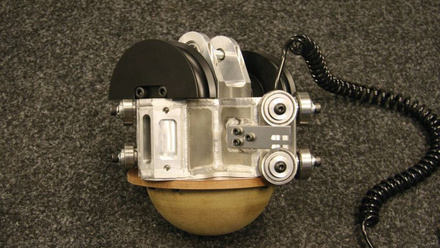Wind propulsion technologies make waves in shipping
Wind propulsion technologies have the potential to significantly reduce fuel usage and emissions from the shipping industry.
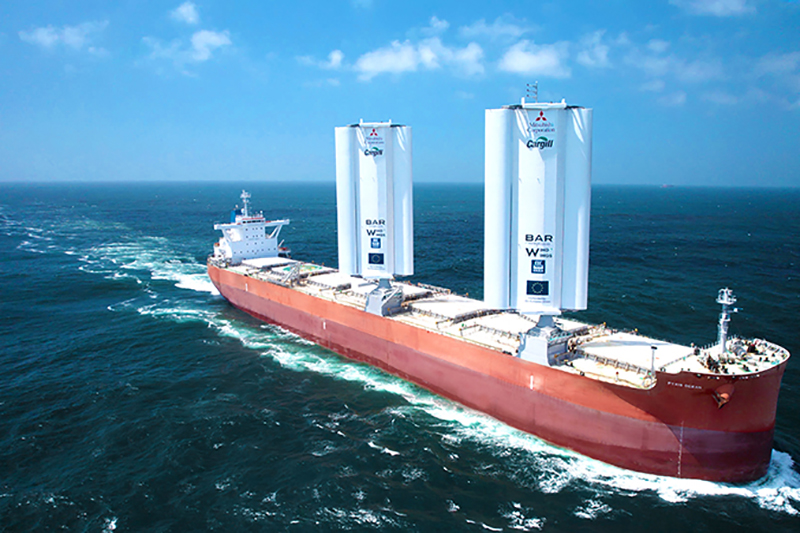
As regulation bites and pressure mounts, the shipping sector is becoming live to new and updated ways to move goods around the world using the oldest source of maritime energy.
'Don’t think of a ship as a boat with a motor. Think of these big container ships as power stations. We are talking 400m long…and something like 20 storeys high. If you put apartments in, you could probably have 50,000 people living in it, so [like] a town with a power station running it. And in these power stations, the engines are monsters – they burn a lot of fuel,' says Gavin Allwright, Secretary at the International Windship Association (IWSA), when I sat down to speak to him about the potential of wind propulsion technology in shipping.
To put his views into perspective, the container ship Emma Maersk is a 397m-long vessel with a beam (width) of 56m that can carry up to 15,200 20ft equivalent units (TEUs i.e. 6m-long containers).
Commissioned with several efficiency features, such as a silicone-painted hull to improve resistance and engine exhaust heat recycling, the largest single diesel unit still consumes around 250t of fuel a day while travelling at 25 knots and sailing 170,000 nautical miles a year, corresponding to seven-and-a-half times around the world.
Some ultra-large container vessels can carry more than 24,000 TEUs and consume 150-200t of fuel a day depending on the size and speed.
The global dead weight tonnage (dwt) – the carrying capacity – for ships was 2.3Bt in 2023 – increased by 70Mt from 2022.
The International Maritime Organisation (IMO) reports that shipping transports more than 80% of global trade, so not only are these ships vast, but there are also a lot of them.
Did you know?
As of January 2023, the world’s merchant fleet consisted of 105,500 vessels of at least 100 gross tonnes (gt), of which 56,500 were over 1,000gt.
Source: The United Nations Conference on Trade and Development Handbook of statistics 2023
And these ships are not just burning petrol or diesel, but are mostly powered by heavy fuel, or Bunker C Oil as it is more frequently called. This emits significant amounts of greenhouse gas (GHG), sulphur oxide, particulates and other emissions.
In 2020, Forbes reported that 60% of the 60,000 ocean-bound, large vessels, such as cargo ships, cruise ships, ferries, oil tankers and bulk carriers, were powered by bunker fuel – mainly due to it being ~30% cheaper than alternatives.
Although, the IMO reports that the amount of sulphur in fuel oil reduced from a maximum 3.5% to 0.5% by 2020, cutting total sulphur oxide emissions from shipping by 70%, almost all of the fleet still relies on fossil fuels, according to the UN’s Review of Maritime Transport 2023. The UN Conference on Trade and Development (UNCTAD) deems the sector’s GHG emissions to have risen 20% over the last decade.
In spring 2023, it also predicted that maritime trade would grow by 2.4% that same year, and more than 2% from 2024-28. UNCTAD warns that without action emissions could reach 130% of 2008 levels by 2050.
A 2023 EU CE Delft report, Shipping GHG emissions 2030 – Analysis of the maximum technical abatement potential, concludes it is possible to reduce shipping emissions by 28-47% by 2030, relative to 2008. This is by using wind-assisted propulsion as efficiently as possible, slowing ships by 20-30% compared to 2018 levels, and using 5-10% of energy from zero-GHG fuels.
This could eliminate 500-1,000Mt CO₂e, with wind-assisted propulsion (among other technical measures) and low-emission fuels accounting for a quarter each, and lower speeds and other operational measures accounting for half.
The winds of change
A submission to the IMO’s Marine Environment Protection Committee in October 2022, from the IWSA and countries including France and Spain, explores the benefits of wind propulsion technologies (WPTs).
The report, Reduction of GHG emissions from ships, highlights industry pressure from bunker fuel cost volatility, decarbonisation uncertainty, compliance burdens, higher costs for new fuels and carbon pricing. It notes, 'WPT solutions are however currently ready, sufficiently mature and available.'
The IWSA’s seven categories of wind propulsion technologies are rotor sails, kites, hard or rigid sails, soft sails, suction wings, turbines and hull forms (see box-out below).
The seven seas of Rhye
The International Wind Shipping Association defines seven broad categories of wind propulsion technologies – all are fully automated:
- Soft sail – both traditional sail and new designs of DynaRig.
- Hard sail – wingsails, foils and JAMDA-style rigs. Some rigs have solar panels for added ancillary power generation.
- Flettner rotor or rotor sails – rotating cylinders operated by low-power motors that use the Magnus effect (difference in air pressure on different sides of a spinning object) to generate thrust.
- Suction wings (Ventofoil, Turbosail) – non-rotating wing with vents and internal fan (or other device) that use boundary layer suction for maximum effect.
- Kites – the deployment of dynamic or passive kites off a vessel’s bow to assist propulsion or generate a mixture of thrust and electrical energy.
- Turbines – using marine-adapted wind turbines to either generate electrical energy or a combination of electrical energy and thrust.
- Hull form – redesigning the hull to capture wind power to generate thrust.
Direct wind energy is described as an abundant, efficient, zero-emissions energy source that does not require energy conversion and so avoids up to 90% power loss compared to alternative fuels. Free and incurring no tax, the report notes that direct wind energy is increasingly predictable through modern forecasting technologies that incorporate a century of wind data and onboard weather sensors, like LiDAR – light detection and ranging.
WPTs are also deemed to be compatible with other fuel and technologies, and further optimisation is possible by integrating them into energy management plans. While WPT does increase power at slower speeds, it is also reported to maintain higher speeds with lower fuel. This is in tandem with increasingly sophisticated wind-routing software, which enables operators to maximise wind exposure while maintaining schedules.
WPT does not take up too much deck space, says the report, but reduces other energy storage needs. Folding and modular systems can help with port operations and height restrictions.
The report adds that 5-20% of a motor ship’s propulsion energy can come from retrofitting WPT, which rises to 30% with wind optimisation routes, and to more than 50% (potentially all) for newbuilds.
In the report, analysis of a wind-assisted Panamax bulk carrier with four rotor sails finds that it could reduce carbon intensity by 22.3%, alongside speed reductions and other post-2008 measures, compared to a business-as-usual voyage reduction of 13.6%.
Voyage optimisation increases this reduction to 27.8%, while increasing the journey time by 20% reduces the carbon intensity by over 40% and a 70% reduction is possible if the voyage takes half as long.
Allwright highlights that wind routing software can run thousands of simulations in a few minutes, using 50-60 years of weather data. Owners and captains may need to accept a 10% increase in the estimated time of arrival to capitalise on the wind, or can minimise fuel burn even further by maximising wind exposure on a wider spectrum of routes.
Although currently used more for design and digital twins, Allwright says LiDAR technology could operationally map wind three-to-four minutes away so the computer can adjust the sails.
'Actually, the wind is pretty predictable in that sense. Not the swirl one or two kilometres around the ship, but generally, in trade wind areas it is very predictable,' says Allwright. He notes though that more wind means more waves, the resistance of which needs considering.
He suggests cargo ships, bulkers and tankers are low-hanging fruit. 'A commodity is basically being taken from one stockpile and delivered to another. So just-in-time delivery is not really relevant. You could spend an extra week at sea, and nobody really minds.'
He notes that primary wind ships are coming into operation this year, where the main source of propulsion comes from wind, and the engine is an auxiliary source. These commercial ships, one of which is 136m long, can operate at 60-80% with wind because of their design. 'Can wind move any ship? Yes, it can. Can it move at a commercially acceptable speed? That’s where the business case start’s getting in the way,' adds Allwright.
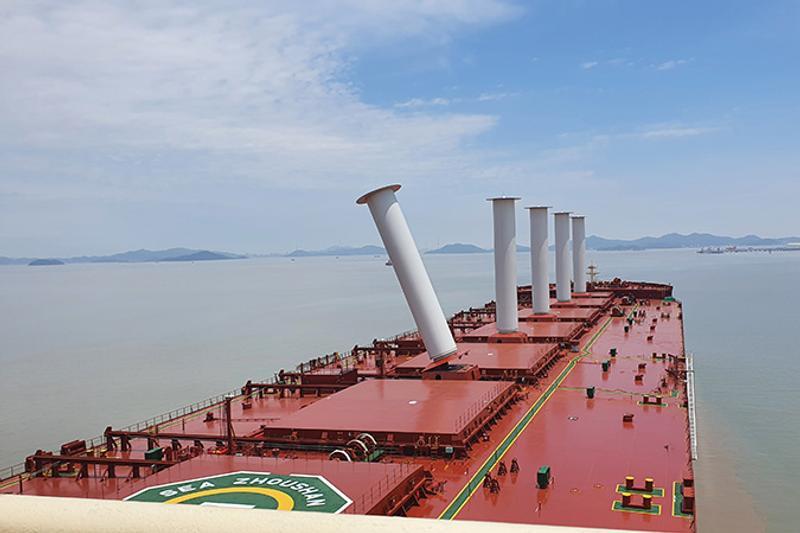
Horsepower
Founded in 2012 in Finland, Norsepower has modernised the Flettner rotor – which first powered a solo Atlantic crossing back in 1926.
The funnel-like rotor sails produce thrust using the Magnus effect. When wind hits the surface of the spinning rotor, air flow on one side accelerates and decelerates on the other. This creates a pressure difference and a force that is perpendicular to the wind, like a curving spinning ball. A minimal amount of the ship’s electric power rotates the cylindrical sails on the ship’s deck.
Norsepower claims its rotor sail is around 10 times more efficient than a conventional one and suitable for many ships, having installed them commercially since 2014 onto roll-on roll-offs (RoRos), bulk carriers, tankers and CO₂ carriers.
The spinning cylinder is a laminated composite surface of carbon and glass fibre, with foam in the middle – made from more than 300,000 recycled plastic bottles on average.
The company has several patents and five products ranging from 18-35m high. The smaller 4m-diameter rotors can turn 225rpm, while the 5m-diameter models can spin at 180rpm.
The rotor sails weigh between 27-63t, and a welded steel foundation adds 12-24t. They can operate at temperatures ranging from -20°C to 50°C, in wind speeds up to 35m/s (126km/h) and survive 75m/s (270km/h). The smallest rotor delivers 175kN of thrust, while the largest can provide 350kN.
Chief Customer Operations Officer, Jukka Kuuskoski, explains that a ‘beam reach’ – when the wind is at a right angle – is the most beneficial point of sail, but thrust can be generated from a wide range of wind directions as with a normal sail, even at close headwinds when the wind is plus or minus 20° from the bow.
The company is implementing ‘sentient control’ to optimise each rotor individually rather than in tandem, Kuuskoski notes, working to reduce fuel consumption from the ship’s main propulsion. Otherwise, they switch to idle to use less than 1kW.
Norsepower recommends they rotate slowly to maintain their bearings, which also reduces drag compared to a fully stopped rotor. Some foundations can tilt up to 90° to reduce height or free up deck space, such as for bulk carriers loading or unloading using cranes and conveyor belts.
With more than 260,000 hours of real-life operation, Norsepower hones its design with this data. 'We are not the ship operators, so we don’t know all the conditions that the ship is going into and how rough…this is the way we are refining the systems continuously,' Kuuskoski says.
He stresses that third-party companies verify their performance and fuel-saving claims such as Lloyd’s Register.
Norsepower says its rotors save 5-20% of fuel, depending on wind conditions, with the greatest savings in windier areas like the North Atlantic, North Pacific or North Sea. Time-off sailing can be a factor, as some boats have longer port stoppages. Kuuskoski therefore cautions against comparing percentages between ships, as larger ships save less fuel compared to smaller ships with similar sail configuration.
Norsepower is exploring software to factor rotor sails into route algorithms, to maximise fuel saving, while also accounting for wave height, currents and wind conditions. 'So they’re not necessarily taking any longer time to cross the Atlantic for example, but they might be using a longer distance route to save more fuel,' Kuuskoski says.
In quarter three of 2024, the first dedicated coal carrier with a rotor sail should save 6-10% of fuel if navigation is optimised, claims the firm.
The biggest criterion for installation is deck space, so the rotors avoid turbulence from each other, and deck architecture. New builds are more flexible, explains Kuuskoski, as designs can maximise the number of rotors. 'There are thousands of ships that are say less than 10 years of age, which still make a lot of sense to upgrade [to] make sure that they are commercially competitive for the next 20 years.'
While economics drive investment, Kuuskoski sees pressure from regulation, markets and ship charterers, with more than just first-adopters interested, who typically 'have a very strong strategy for decarbonisation and sustainable operations'.
Regarding alternative fuels, Kuuskoski says, 'The cost of such fuels will be high. Of course, availability is still scarce, but when they become more available, cost will still be high. So it makes even more sense to save as much fuel as you can'.
The firm bills itself as a leading provider of mechanical sails for large ships, but also recently announced a leasing initiative to help small-to-medium shipowners and operators with the upfront capital.
Wind-ready
At the end of 2022, the IWSA estimated 25 large commercial ships to have WPT systems, with over a combined 1.2mln dwt carrying capacity and 51 rigs installed. The association forecasted there would be 16 ships with rotor sails, another 16 with suction wings, eight with rigid sails, six with kites and three with a soft or hybrid sails by the end of 2023.
Moreover, a 2019 Frontier Economics report for the UK Department for Transport, on Reducing the maritime sector’s contribution to climate change and air pollution, estimates the WPT market size to represent 37,000-40,000 ships, or 40-45% of the global fleet by 2050, assuming 50-100% of GHG abatement.
While rotors sails seem to be the frontrunner, Allwright clarifies that market dissemination and scaling is relatively new and it is too early to identify trends. Although rotors are a very credible option, they were commercialised earlier, with the first such sail installed in 2010. 'More recently, we’ve had the suction wing systems and the rigid wings, and of course there are different vendors, systems and styles, but those have been introduced later.'
Many systems have both soft and hard elements, and they can also be active or passive. 'A flettner rotor is obviously rotating very fast. It has a motor, so that is an active system, and a suction wing is in-between,' Allwright shares.
A kite meanwhile is off-the-deck and takes up a small amount of space at the bow. 'A kite is very versatile across all ship types, but I would say one of the easy areas where it has no competition is retrofitting onto container ships,' says Allwright.
With containerisation, a wind system can be loaded and unloaded like a container and transferred from ship to ship. Allwright notes that Flettner rotors only take a few hours to fit onto existing foundations. 'MOL, one of the largest shipping companies in the world, have developed a wing-sails system, which took around two hours to install.'
The market consists of over 10 companies supplying a variety of sizes and powered WPTs, with 10 more at pre-market and 20 more in the R&D pipeline, says the IWSA 2022 report.
Spanish company bound4blue installed two 17m-high suction sails on the Amasus-owned general cargo vessel Eems Traveller in 2023. The company claims its eSAIL produces seven times more lift than an aircraft wing. The eSAIL is similar to a Flettner rotor, but sucks air through a porous area of the outside skin to keep the airflow attached to the spinning sail.
A manoeuvrable flap creates the appropriate aerodynamic shape and covers the suction area not in use.
Econowind in the Netherlands also makes suction wings. Its two 16m x 2.8m VentoFoil units were installed onto the MV Sunnanvik for SMT Shipping in quarter four of 2023. One product comes in a ~12m sea container for easy lifting on and off.
The VentoFoil is a wing-shaped element that integrates suction, doubling the force, and can be reefed when needed. The wings rotate automatically and can fold into a container for storage in unfavourable conditions.
BAR Technologies in Portsmouth, UK, is a spin-off from the Ben Ainslie Racing team that competes in sailing competitions. After being awarded a full design approval certificate last summer, BAR Tech, Yara Marine Technologies and collaborators installed WindWings on Pyxis Ocean.
This is a Kamsarmax-size 80,000dwt ship, chartered by Cargill. The six-year-old bulker was retrofitted with two ~37m-tall sails. BAR Tech expects the wings to save an average of 30% a year in fuel, but will monitor the first deployment on a large commercial ship to further improve the design and operation. Each WindWing reportedly saves ~1.5t fuel per day on average, while reducing 4.65t of CO₂ emissions.
Meanwhile, Airbus leveraged its aeronautical expertise to the Airseas venture to develop Seawing – an automated kite system to tow cargo ships. The 1,000m² sail surface aims to reduce fuel consumption by 20% on average, and like other systems is also fully automated.
Japanese shipping company Kawasaki Kisen Kaisha was the first to install one in 2022 onto a Capesize bulk carrier. The second will be a newbuild, liquefied-natural-gas-fuelled, 210,000dwt bulk carrier due in 2024. Airseas had a 20-year agreement with the Japanese company to install Seawings on up to 50 vessels, but has recently been brought by them.
Mining company Vale has also got in on the act and agreed with Omani shipowner Asyad to install rotor sails on the Sohar Max ship, making it the world’s largest with a WPT. Such Valemax vessels are reported as the world’s largest ore carriers at 362m long, 65m wide and a 400,000t carrying capacity.
British company Anemoi manufactures the 35m-high and 5m-diameter rotors to be installed, which Vale believes will increase efficiency by 6% and cut up to 3,000t CO₂e a year. The five rotors will remain in situ for the vessel’s life and the company is targeting 8% fuel savings a year.
Sohar Max is part of Vale’s wider Ecoshipping programme with Asyad to pilot innovative technologies on four ships and reduce emissions in line with the IMO requirements (see box-out below). Technologies include silicone paint to reduce resistance, frequency inverters to reduce electricity usage and hydrodynamic devices to improve propulsion.
Regulating the high seas
Shipping is under pressure to reduce its emissions as a sector. In July 2023, the Member States of the International Maritime Organisation (IMO) revised their greenhouse gas (GHG) strategy, targeting a 70% reduction – while striving for 80% – in absolute emissions by 2040. This assumes the average ship must reduce its GHG intensity by ~90% by 2040 due to increased trade volumes.
Emissions including CO₂, methane and nitrous oxide from shipping increased by 9.6% in the period 2012-18.
The strategy also aims for 5-10% of shipping to have zero or near-zero GHG emissions by 2030. There are mid-term measures for 2025, including a fuel standard and a GHG pricing mechanism.
As of this year, the EU’s Emissions Trading System (ETS) has been extended to cover CO₂ emissions from all large ships – of 5,000 gross tonnes or more – entering EU ports, regardless of the flag they fly.
This covers 50% of emissions from voyages starting or ending outside the EU, and 100% of emissions that occur between two EU ports for CO₂, methane and nitrous oxide – albeit the latter two will only be included from 2026.
The cap will reduce over time, so all ETS sectors must contribute to and incentivise energy efficiency, low-carbon solutions and reductions of the price difference between alternative fuels and traditional maritime fuels.
In practice, shipping companies will need to purchase and surrender EU ETS emission allowances for each tonne of reported CO₂ emissions.
'We selected our pilot [initiatives] based on the scalability potential to replicate to other vessels. There are currently 68 Valemaxes that could benefit from the results and learnings of this project, and 50 Guaibamaxes that are already benefiting from the existing pilot on MV Sea Zhoushan,' explains Vale’s Shipping Technical Manager Rodrigo Bermelho.
While rotor sails were chosen after a technology review, Bermelho says they are continuing to follow-up with partners testing other technologies.
Fitting rotors onto other boats will depend on the fuel savings realised versus equipment costs. Bermelho says the sails remain very expensive and they are looking for a significant price reduction in the near future.
The new generation Guaibamax is under negotiation, Bermelho reports, which includes a list of leading technologies from the Ecoshipping programme.
But what about retrofitting older ships more widely? UNCTAD reports that the average ship is 22.2 years-old, and half are more than 15 years-old. 'Many ships are either too old to retrofit or too young to scrap,' says the organisation, posing a conundrum.
It estimates that decarbonising the world’s fleet by 2050 could cost US$8bln-$28bln a year, and estimates 100% carbon-neutral fuel infrastructure costs of US$28bln-$90bln to run across the fleet a year.
Many shipowners would therefore question the merit of a wind system for an older ship, but Allwright stresses that the WPT does not have to be scrapped at the end of a ship’s life, but can be removed and welded onto another.
Market mechanisms
He points to volatility in the sector being an issue, with a boom-and-bust cycle of ordering ships when times are good, and none when charter rates drop. As well as a long lifetime, there is a lack of consistent planning for ship orders. 'I think many industries are struggling with this – we’re not set up for a future which has that slack, we’re coming up to extremely difficult situations with climate, with resilience. We are always talking about efficiency, but we very rarely talk about what a fleet is in 2050. What does it look like? What are the trades it will actually be supporting?'
While China is currently the largest ship production centre, Allwright says development will be more multi-nodal, with manufacturing growing in India, Indonesia, South America and Africa. 'The big idea in container ships especially is bigger is better. You have 24,000-26,000 TEU vessels, yet there are only a small number of ports that can actually take those.'
Leaving the strategy to the market is flawed, Allwright says, as it is 'very poor at delivering a resilient industry for 2050, because it simply doesn’t work that way'.
While ship charterers consider monthly and annual profits, ports plan bridge heights and bunkering infrastructure for the long-term. Many stakeholders are 'looking at 10, 20, potentially 50-year investment horizons, and everything in between. And they are all trying to talk to each other', and figure out the technology to bank on.
Allwright believes the economics are unfairly compared as fossil fuels are artificially supported, with the International Monetary Fund estimating ~US$1trln of direct subsidies and US$6trln indirect, such as for pollution controls or health costs.
He reports that alternative fuels are generally estimated to be three-to-five times the cost of heavy fuel, and subsidising them to match fossil fuels, '…creates an artificial market, which we are paying a huge amount of money for'.
The IWSA argues that wind energy counts as a fuel and so should not be punished by this subsidy. As WPTs don’t need infrastructure and are compatible with other options, a wind ship will always be hybrid.
He stresses, 'Regulatory compliance [is] a big thing, not just from the IMO but from the EU' (see box-out above).
On course
There is a large momentum for WPT installations, Allwright asserts. 'We are moving from individual demonstrators into fleet orders now. So, they’re still small, like 5, 10 ships, but we have got wind-ready ships also coming out of shipyards, where all the base work has been done to take wind systems later. So, the market is already moving quite strongly. We are looking at doubling the number of ships every single year going forward and that’s conservative.'
Wind turbines are around 20-30 times larger than they were in the 1980s and 90s, Allwright points out. 'We are in the 80s and 90s at the moment with wind propulsion. The systems are growing.' The first rotor sail was 18-20m and 35m is now a standard size. Indeed, a demonstration wind system from Chantier d’Atlantique – one of the largest shipbuilders in Europe – is 76m-high and is both tiltable and retractable.
'They are getting more powerful. Also, we’ve got the learning curve and economies of scale kicking in…So just at the time when fuel prices are going up, with carbon taxes and new fuels coming in, we’re starting to see the power of the systems getting better.'


